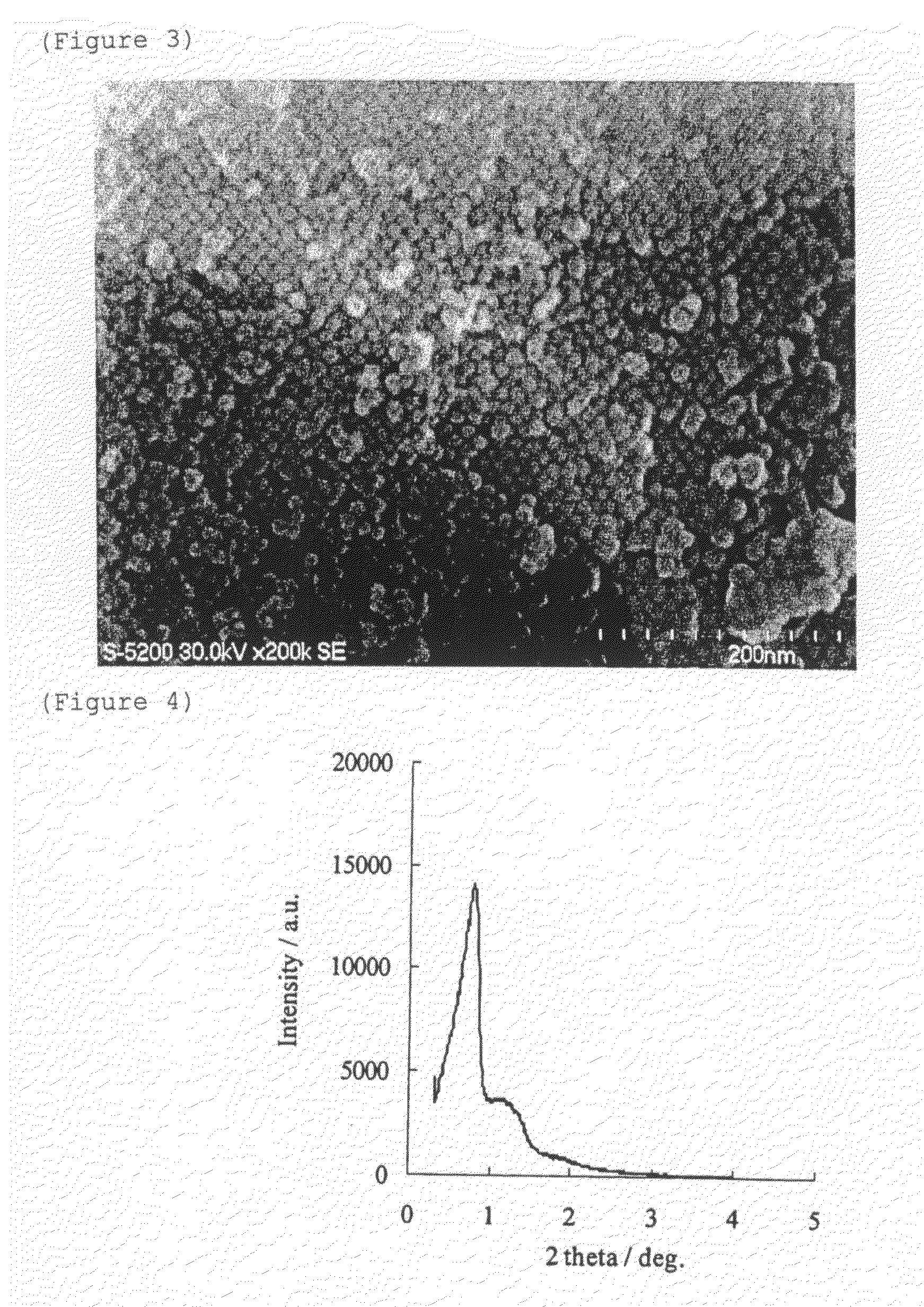Regularly Arranged Nanoparticulate Silica and Process for Producing the Same
a nanoparticulate silica and regular structure technology, applied in the field of self-organized nanoparticulate silica, can solve the problems of unsatisfactory characteristics of composite materials produced by such a method, the distribution of the diameter of the obtained ultrafine particles is not uniform, but usually broad, and achieves the effects of regular structure, large void fraction, and simple production
- Summary
- Abstract
- Description
- Claims
- Application Information
AI Technical Summary
Benefits of technology
Problems solved by technology
Method used
Image
Examples
example 2
[0103]2.92 mg (0.02 mmol) of L-lysine were dissolved in 2.92 g of deionized water at 60° C. to prepare a 1% by mass aqueous solution of L-lysine. This solution was added with 208.33 mg (1 mmol) of tetraethoxysilane (TEOS), stirred at 60° C. for 15 hours and then left for standing at 100° C. for 15 hours. The solution was then dried to a solid. The obtained white solid was recovered and then calcined at 500° C. to obtain 50 mg of a product (yield: 75%).
[0104]Similar operations were carried out with the amounts of 0.05 mmol, 0.10 mmol, 0.20 mmol or 0.50 mmol of L-lysine.
[0105]The results of X-ray diffraction (XRD) of each obtained product are shown in FIG. 10.
[0106]The results show that this range of the amounts of L-lysine has no particular effect on the lattice structure of the product.
example 3
[0107]Similar operations were carried out as in Example 2 except that octanol was added to the aqueous solution of L-lysine (0.02 mmol) in Example 2 so as to be 5% by mass, 10% by mass, 20% by mass, 30% by mass or 40% by mass. In the case that octanol was added so as to be 5% by mass, the molar ratio of the octanol to TEOS was 1.1.
[0108]The results of X-ray diffraction (XRD) of each obtained product are shown in FIG. 13.
[0109]The results show that this range of the amounts of added octanol has no particular effect on the lattice structure of the product.
[0110]The results of X-ray diffraction (XRD) and 29Si-MAS-NMR for both calcined and as-synthesized when octanol was added so as to be 5% by mass are shown in FIG. 6 and FIG. 7 respectively. The measured result of the nitrogen adsorption / desorption (isotherm) curve for calcined is shown in FIG. 8 whereas the measured result of the nitrogen adsorption / desorption (isotherm) curve for as-synthesized is shown in FIG. 9.
[0111]Further, the ...
example 4
[0112]Similar operations were carried out as in Example 2 except that the aqueous solution of L-lysine (0.02 mmol) in Example 2 was added with ethanol, n-butanol, n-hexanol, n-octanol, n-decanol or n-dodecanol each so as to be 5% by mass.
[0113]The results of X-ray diffraction (XRD) of each obtained product are shown in FIG. 16.
[0114]The results show that addition of ethanol presumably has an unfavorable effect on the lattice structure of the product, whereas addition of alcohol of 4 or more carbon atoms has no particular effect and addition of alcohol of 8-10 carbon atoms improves the regularity of the lattice structure.
PUM
| Property | Measurement | Unit |
|---|---|---|
| particle diameter | aaaaa | aaaaa |
| particle diameter | aaaaa | aaaaa |
| specific surface area | aaaaa | aaaaa |
Abstract
Description
Claims
Application Information
 Login to View More
Login to View More - R&D
- Intellectual Property
- Life Sciences
- Materials
- Tech Scout
- Unparalleled Data Quality
- Higher Quality Content
- 60% Fewer Hallucinations
Browse by: Latest US Patents, China's latest patents, Technical Efficacy Thesaurus, Application Domain, Technology Topic, Popular Technical Reports.
© 2025 PatSnap. All rights reserved.Legal|Privacy policy|Modern Slavery Act Transparency Statement|Sitemap|About US| Contact US: help@patsnap.com



